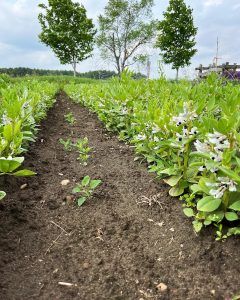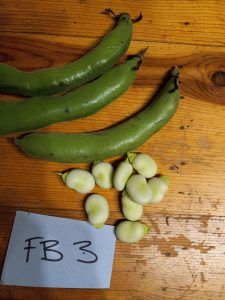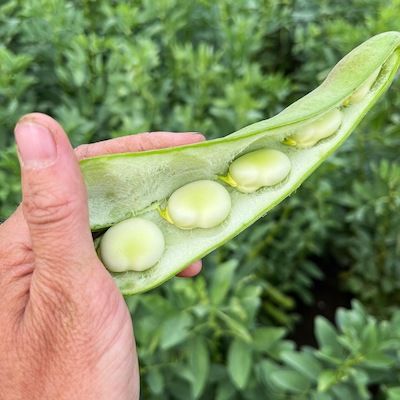By Sarah Larsen
Download this article in PDF format >
Micheline Lalonde, grower at the rooftop farm at Avling Kitchen and Brewing in Toronto, was curious about how well fava beans grew on the rooftop farm. “Fava beans were already being featured on Avling’s menu at the time [in 2021] and we wanted to see what type would have the best culinary use,” says Micheline. “We had never grown fava beans on the roof, so it was an easy choice to experiment with them.”
Micheline and the crew at Avling had previously participated in a Canadian Organic Vegetable Improvement (CANOVI) trial on radicchio and, through this experience, knew a variety trial would help them answer questions about the suitability of different fava bean varieties for the microclimate of rooftop gardens and specially formulated rooftop soil. To conduct the variety trial in 2022, Micheline received funding from EFAO’s Farmer-Led Research Program.
Fava beans (Vicia faba var faba; V. faba var equina; V. faba var minuta), also commonly known as faba bean or broad bean, are a species of vetch and are among the most ancient plants in cultivation. Fava beans are a staple food of the Mediterranean region and across Eurasia, including Egypt, Israel, Turkey, Lebanon, Syria, Iraq, Iran, northern India, Pakistan, and southern China, where they form the base of dishes such as ful, falafel, and hummus. In Europe and North America, the large seeded immature beans are eaten fresh as a delicious plant protein—with or without the seed coat.
 To get the trial started, Micheline and EFAO put a call out for other growers to participate, as a way to gather more information about the varieties across different farm environments. Martina Schaefer of Spiral Farm, Michelle Dang and Sharene Shafie of Toronto Metropolitan University’s Urban Farm, and Leslie Moskovits of Cedar Down Farm answered the call and joined the trial.
To get the trial started, Micheline and EFAO put a call out for other growers to participate, as a way to gather more information about the varieties across different farm environments. Martina Schaefer of Spiral Farm, Michelle Dang and Sharene Shafie of Toronto Metropolitan University’s Urban Farm, and Leslie Moskovits of Cedar Down Farm answered the call and joined the trial.
Martina, who’d already been growing fava beans for several years for her CSA and loved both growing and eating them, wanted to trial different varieties to “diversify the genetics as ‘insurance’ or resilience from season to season,” she says.
Michelle’s motivations to join the trial were to learn about a crop she’d never grown—her experience with fava beans prior to the trial was seeing them dried or canned, or already cooked in food. She also wanted to see how this cool season crop did in the hotter microclimate of a rooftop.
Sharene was also interested in growing fava beans in a rooftop environment and comparing the results from TMU and Avling’s rooftop farms. As an Egyptian, growing fava beans was also personal, since it is a culturally significant crop that she uses in many traditional dishes.
Like Martina, Leslie had been growing fava beans for years for her CSA and she always loved them. More recently, however, “we stopped growing them because we found that not many CSA members were familiar with them and often chose not to take them,” she says. At the same time, Leslie’s personal love of fava beans grew through a relationship with a Syrian family who Leslie helped sponsor. “We share a deep love of food, and fava beans are a very important food for them and we often eat ful together,” says Leslie.
“Because of our Syrian friends, I started growing fava beans again for them. I wanted to be part of the trial to make fava beans available to more people in our community for whom they are an important cultural food.”

To conduct the trial, the farmers grew six varieties of fava bean, including Tendergreen from Backyard Seed Saver; Windsor from Gaia Organics; Witkiem- Monica from William Dam; Vroma from Johnny’s Selected Seeds; and two varieties from Vicia Genetics bred by Jessica Hughes in Saskatchewan, which are not yet commercially available. The farmers chose to grow two replicates of 3 to 6 of the varieties, with at least 10 plants per replicate, and collect data on general crop management, germination, early season vigour, lodging, yield, taste, flavour, texture, overall performance; and observations on crop health.
Overall, the growers found out that growing fava beans in southern Ontario— whether on rooftop farms or in-field—is tricky! “Our spring weather fluctuates wildly and fava seems not to like hot, humid weather or the temperature swings that we’ve been having,” explains Leslie. “They also are afflicted by various insect pressures and in general are challenging to get a fulsome crop,” she observed.
The other growers also noted problems with disease pressure from aphids and the clear need for consistent cool season weather.
“My main takeaway from this trial,” says Michelle, “is that fava beans really are cool season crops. Once temperatures outside get above ~18°C, the beans start pushing to grow quickly which led to abnormal bean development and this really influenced yield and marketability.”
Similarly, at Avling’s rooftop farm, Micheline reflected that “perhaps a rooftop is not the most ideal environment for fava beans.” At the same time, she was surprised to observe “considerable differences in the taste of fava varieties, some more favourable for culinary purposes than others, such as the Witkiem-Monica variety.”
Experimenting with eating the fava beans that did produce was another highlight at the Urban Farm. “Fava beans can literally be eaten any which way: raw, cooked, beans with the skin on, or beans with the skin off!” exclaimed Michelle. “It’s really up to your preferences for flavour, texture, and the amount of time and energy you have to prepare the beans for eating.”
Michelle also enjoyed sharing the fava with her friends for which fava beans are culturally significant. “Every week,” says Michelle, “my friend who is Lebanese would be so joyful and grateful for receiving the fava beans, and she would rush back home and share them with her mom who hasn’t been able to find fresh fava beans in Canada since immigrating. Her mom would cook so many fava bean centered dishes, like riz by foul or fava bean hummus, and used to share it with farm staff when she could. The food was delicious!”
“Another friend who is Egyptian,” Michelle continues, “told me in Egypt, they often would eat fava beans raw as a snack. His dad started popping some beans we grew into his mouth and said, ‘Not as good as in Egypt, but still good.’“
Despite the tricky year growing fava beans in 2022, Sharene, Martina, and Leslie have been joined by Dillon Muldoon of the Trent Research Farm to trial them again in 2023. This year, they started the beans earlier to try to catch cooler spring conditions, and are planting three replicates each of Windsor from Gaia Organics and the two varieties from Jessica Hughes again, along with Andy’s Broad Bean from BC Eco-Coop. They also plan to observe aphid predation to learn more about disease pressure in fava beans and discern any resistant varieties.
Hopeful for a better crop in 2023, Sharene says “this year I intend to make ful!”
To make your own ful from fava beans, check out this recipe shared by Martina.
—
Sarah Larsen is EFAO’s Research & Small Grains Program Director and also supports soil health components of EFAO’s education programs. She holds a Ph.D. in Soil Microbial Ecology from Iowa State University, and along with her partner and their daughter, tends the land that they call Three Ridges Ecological Farm near Aylmer, Ontario.

